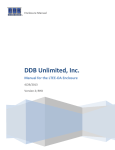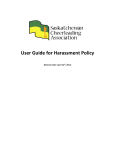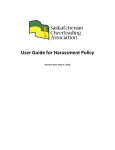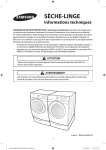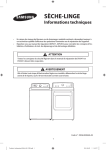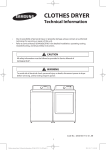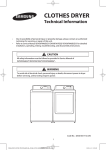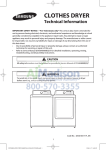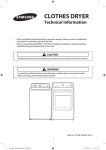Download DDB AIR CONDITIONER SYSTEMS Installation manual
Transcript
AIR CONDITIONER SYSTEMS FOR ELECTRONIC ENCLOSURES OPERATIONS AND INSTALLATION MANUAL 1 Operation and Installation Manual **IMPORTANT** For safe and satisfactory operation, please read this manual and follow the instructions for installation and operation of this system. Keep this manual for future reference. Some information may not apply to your system. Where To Find Information On Introduction Page 3 Basic Operation Page 4 Unpacking Inspection Page 4 Pre-installation Test Page 5 Preparing The Enclosure Page 6 Operating Your System Page 7 Programming The Controller Page 8 Alarm Operation Page 9 Maintenance Page 10 Troubleshooting Page 11 Schematic Wiring Diagram Page 12 Warranty Back Page 2 Introduction DDB computer and electronics enclosure cooling systems have been designed to provide a friendly environment for your equipment by cooling and de-humidifying the enclosure, which houses your equipment in an efficient, modern, aesthetically pleasing package requiring minimal maintenance. The closed-loop circulation design also protects your equipment from air-borne dust and contaminants, which may hinder your equipment operations and cause unnecessary downtime. DDB offers models ranging in cooling capacity from 1,000 to 20,000 BTU per hour to provide cooling systems for many of your conditioning needs. DDB also offers select models in enclosure top and side mount packages. 3 Basic Operation The DDB air conditioning system is actually three systems, which function simultaneously to maintain environmentally friendly conditions for your equipment within the enclosure. These are the closed-loop cold air system, the warm air system, and the vapor-compression refrigeration system. The closed-loop cold air system circulates cold air from the cooling system to the electronics enclosure. The air then returns to the system, bringing with it unwanted heat and humidity from within the enclosure. This heat and humidity is removed by a heat exchanger within the system. This heat exchanger is part of the vapor-compression refrigeration system. At the heart of the vapor-compression refrigeration’s system is a quiet, energy efficient rotary compressor, which circulates NON-CFC refrigerant to transfer heat from the heat exchanger (evaporator) located within the closed-loop air stream to a heat exchanger (condenser) located in the warm air system. In the warm air system, air is circulated from the ambient surrounding the enclosure, through a filter and across the warm air heat exchanger. Here, heat from the enclosure is transferred from the warm air heat exchanger to the warm air stream and dissipated to the ambient. Unpacking Inspection What to look for: 1. Shipping container is banded to the pallet and arrows on the shipping container are pointing in the proper (upward) direction. The system is position sensitive. DDB recommends the unit to remain in the proper upright position, as indicated on the shipping container, for a minimum of 24 hours before initial operation to ensure the oil has returned to the compressor. Operation before the 24-hour time may cause compressor damage and shorten the life of the system. Operation before this 24hour period will void all warranties. 2. Damage to the shipping container. If the shipping container has been damaged or marred in any way, carefully inspect the unit for damage, which may have occurred during shipping. Check for scratches, dents, or rattles indicating loose components, presence of oil, or any other irregularities. Any evidence of damage should be recorded on the freight bill. The freight carrier’s claim procedure should be followed. DDB cannot accept responsibility for damages that occur during shipping. 4 Pre-Installation Test Before installing the system on your enclosure, it is a good idea to operate the unit for a few minutes to ensure it is functioning properly. Although the system has been tested at the factory, internal damage may have occurred during shipping which may not have been apparent during the unpacking inspection. This procedure will also help to familiarize you with the unit. 1. Place the system on a solid base such as a workbench or table. Be sure to allow for adequate space for airflow. There are two air streams that must not be restricted, the cold air stream and the warm air stream. Top mount units must be elevated to provide adequate airflow for the cold air stream located on bottom of system. Check the Model # to determine whether it’s a Top or Side mount air conditioner. Top mount units can only be mounted on a flat horizontal surface and Side mount units can only be mounted on a flat vertical surface. 2. Check that the warm air system filter is in place. (Location varies with model type) *Models with the optional rain or wash down hood do not have this filter and require regular condenser maintenance. 3. Check the data tag for proper electrical requirements. The data tag will give the voltage and amperage requirements of the system. Be sure the electrical outlet where the system will be connected has the proper capacity. After noting the above, connect the power cord to a properly grounded electrical outlet. An extension cord is not recommended. ** If any unusual noise or vibration is present during the testing procedure, immediately disconnect the power cord and inspect the unit for the cause of the noise or vibration and contact Ice Qube immediately. 4. As soon as power is supplied to the system, the cold air evaporator blower will begin operation. The compressor and warm air condenser blower will not operate if the room air temperature is below 80’ F. This is because the temperature controller has a factory set point of 80’ F. (The digital display on the face of the controller will be displaying room temperature.) If the display is indicating 80’ F or warmer, the cool status LED will flash for 3-1/2 minutes before the compressor and warm air condenser blower will operate. If the display is indicating a temperature less than 80’ F, you must change the set point to a temperature lower than the room temperature in order for the compressor and warm air condenser blower to operate. (Refer to the section on the Temperature Controller in this manual.) 5. With the compressors and both blowers operating, allow the unit to operate for 20 to 30 minutes. This will provide sufficient time for the vapor compression system to achieve operating balance. Measure the cold air outlet temperature with an accurate thermometer. This temperature should be at least 10’ F colder than the inlet air temperature if the room temperature is warmer than 70’ F. Inlet air temperature will be displayed on the temperature controller. (In areas where the humidity is high, the temperature difference may be less than 10’ F.) 6. After completing these few simple checks, you are ready to prepare the electrical enclosure for installation of the unit. 5 Preparing the Enclosure DDB air conditioning systems have been designed to be lighter in weight for easy installation. Our wall (vertical) mount units have been designed with a simple “two stud” alignment feature to make initial fastening to the enclosure quick and easy. A few modifications must be made to your enclosure to provide proper air flow, maintain enclosure integrity and assure secure installation. Required modifications will vary with air conditioner model. 1. Determine the location of the unit system on your enclosure. **Caution** With wall mount units, be sure the weight of the air conditioning system will not cause the enclosure to become unbalanced causing bodily harm or equipment damage. For units mounted on enclosure doors, be sure the hinges will support the weight of the unit. Refer to system specifications for model weights. 2. Upon deciding the location of the unit on the enclosure, attach the template which has been packaged with your system to the enclosure surface. (You can use the template to help you decide unit location.) Be sure that the unit will be mounted level and that the inlet and outlet of the cold air stream will not be restricted by equipment or shelving within the enclosure. Also check that the air flow of the warm air stream will not be affected or restricted by surroundings. 3. Outline the modifications to be made to the enclosure using a marking pencil. Note the boltholes, cutouts for the inlet and outlet air streams, and the power cord. 4. Make the holes for the studs, bolts, and power cord using a drill. (Bit size will vary with model.) Be sure to protect any equipment located within the enclosure from debris produced during the installation procedure. 5. Drill a pilot hole for a saber saw to cut the inlet and outlet air passages. File all cuts to provide a uniform cutout. 6. Slide the mounting studs through the matching holes in the enclosure and check to see that all openings are aligned. (Top mount units do not have mounting studs.) 7. After checking that all opening and bolt holes are in alignment, apply the gasket material ( provided with your system ) to the air conditioning system cabinet to ensure an air tight NEMA integrity. *Caution* Be careful while removing the backing on the gasket material. The material may stretch and the holes will not align. *Note* If the enclosure is not air tight or the air conditioning system operates with the enclosure door(s) open, a great deal of moisture will condense inside of the air conditioning system and possibly overflow the condensate management system. 8. After all gasket material has been installed, mount the unit onto the enclosure and fasten it using the nuts and bolts provided with your system. Check to be sure all fasteners have been tightened securely and the gasket material is in place to maintain enclosure integrity. You are now ready to operate your unit. 6 **Note** Near the bottom or on the side of the cabinet, you will find a nipple which is for condensate overflow. Although all DDB units have built-in condensate management systems, you may find it necessary to attach a hose to this nipple on enclosures that are located in extremely humid conditions, when enclosure doors become left open or the door seals are leaking. Top mount models do not have a built in condensate evaporation system. Operating Your System After installing the unit onto your enclosure and attaching the power cord to a properly grounded electrical outlet with adequate voltage and current supply, you are ready to begin operation of the system. As soon as electrical power is supplied to the unit, you should hear the cold air stream blower operating immediately. This blower operates continuously so that the temperature controller can constantly monitor your enclosure’s internal temperature. Enclosure temperature will be displayed on the face of the controller. If the enclosure temperature is above the factory cooling set point of 80 degrees Fahrenheit, you will see the cool status LED flashing. This indicates that the compressor’s automatic off cycle timer is working. (The off cycle timer is factory set at 31/2 minutes.) At the end of 3-1/2 minutes, you should hear the compressor and the condenser air blower start. This signifies that the cooling system has begun operation to remove heat and humidity from within the enclosure. (It may take 20 to 30 minutes operating time to reach full capacity.) If the heat load within the enclosure is less than the BTUH capacity of the of your Ice Qube system, you will notice the temperature on the digital display begin to decrease. When the temperature inside the enclosure decreases 7 degrees Fahrenheit below the cooling on set point, the compressor and the condenser blower should cycle off, but the cold air blower will continue to operate, circulating air within the enclosure. (The controller has a factory programmed temperature differential of 7 degrees Fahrenheit.) Example: Cooling on @ 80 degrees F Cooling off @ 73 degrees F Programming the Controller The digital controller offers many features which you may or may not decide to use. However, the controller has been programmed at the factory with default settings for system operations which are satisfactory for many applications. Please review the following default settings to see if they are correct for your enclosure application. 1. 2. 3. 4. 5. 6. 7. 8. Cooling system on temperature - 80 degrees Fahrenheit Heating system on temperature - 50 degrees Fahrenheit (Optional) High enclosure temperature alarm - 100 degrees Fahrenheit Low enclosure temperature alarm - 40 degrees Fahrenheit Audible and Visual alarm - On Digital display in degrees Fahrenheit Filter maintenance alarm - 30 Days High condenser temperature alarm - 170 degrees Fahrenheit 7 If you wish to change the factory default settings, you must enter the programming code which is factory set at the sequence of : Adjust-up (1) arrow, Adjust-down (2) arrow, Select (3), then Exit (4). After pressing the above sequence and the code is accepted, the program LED should be on, and the digital display on the face of the controller should be flashing three alternating boxes. If no selection is made within one minute, the system returns to the normal operating mode. **Note** Pressing the exit (4) button at any time while in the programming mode returns the controller to the normal operating mode. Press the Select (3) button to continue programming. The set temperature hi LED is on with the display indicating the cooling on set point. The compressor will begin operation at this temperature and remain operating until the enclosure temperature decreases approximately seven degrees Fahrenheit. (Four degrees Celsius) Press the Adjust-up (1) or Adjust-down (2) arrow until the desired set point is displayed within a range of 70 to 126 degrees Fahrenheit (21 to 52 degrees Celsius). When adjustment is complete, press the Select (3) button to continue. The set temperature lo LED is on with the display indicating the (optional) heating on set point. The heating system will begin operation at this temperature and remain operating until the enclosure temperature increases approximately seven degrees Fahrenheit (Four degrees Celsius). Press the Adjust-up (1) or Adjust-down (2) arrow until the desired set point is displayed within a range of 40 to 63 degrees Fahrenheit (4.5 to 17 degrees Celsius). **Note** If you have changed the cool on or heat on set points, be sure to review the alarm settings. Press the Select (3) button to continue. The set alarm hi LED is on with the display indicating the high temperature alarm set point. The alarm will activate at this temperature and will automatically reset at 2 degrees Fahrenheit (1 degree Celsius) below this temperature. Press the Adjust-up (1) or Adjust-down (2) arrow to change the alarm set point in a range from 8 degrees Fahrenheit (4 degrees Celsius) above the set temperature hi set point, to 135 degrees Fahrenheit (57 degrees Celsius). Press the Select (3) button to continue. The set alarm lo LED is on with the display indicating the low temperature alarm set point. The alarm will activate at this temperature and will automatically reset at 2 degrees Fahrenheit (1 degree Celsius) above this temperature. Press the Adjust-up (1) or Adjust-down (2) arrow to change the alarm set point in a range from 8 degrees Fahrenheit (4 degrees Celsius) below the set temperature lo set point, to 34 degrees Fahrenheit (1 degree Celsius). Press the Select (3) button to continue. The alarm LED will flash and the display will show ALL indicating the all alarm on/off status. Press Select (3) and the display will show either ON or OFF indicating current alarm status. Press Adjust-up (1) or Adjustdown (2) to toggle the mode as desired. If the off mode is selected, no alarms will activate and the audible on/off select function is skipped. Press the Select (3) button to continue. The audible LED will flash and the display will show AUD indicating the audible alarm on/off status. Press select and the display shows ON or OFF indicating the current audible alarm status. Press Adjust-up (1) or Adjustdown (2) to toggle the mode as desired. Press the Select (3) button to continue. The C LED flashes and the display shows either F for degrees Fahrenheit or C for degrees Celsius. Press Adjust-up (1) or Adjustdown (2) to toggle the mode as desired. 8 Press the Select (3) button to continue. The code LED is on and the display shows PIN. To set a new user PIN code, press the Adjust-up (1) button. The display will flash 4, prompting an entry of a four button sequence using the Adjust –up (1), Adjust-down (2), Select (3) and/or Exit (4) buttons. (Any sequence of the four buttons may be programmed as your code.) As the buttons are pressed, the display will show the number of buttons pressed. (After pressing a button, you will have approximately 5 seconds to press the next button. If you do not press the next button in the allotted time, the system will default to no PIN code indicated by 0 on the display.) Once the sequence is entered, the display will no longer flash, but will show 4. To program the no PIN code mode, press Adjust-down (2) and the display will show 0 indicating no PIN code. With no PIN code, pressing any button will permit access to the program. **Caution** Always record the selection sequence (PIN code) and store in a secure place. Press the Select (3) button to continue. The filter LED flashes and the display shows FIL indicating the filter alarm days selection. Press the Select (3) button and the display will show the number of days that the alarm is set in one-half day increments. (Example: 10.5 indicates the alarm will activate every ten and one-half days.) Press the Adjust–up (1) or Adjust-down (2) arrow to adjust the desired number of days. Programming 0 days will disable the alarm. *Note - The required number of days to set this alarm will be determined by your ambient air conditions. If rain or wash down hoods are installed on your system, no filter is supplied with your system and the filter alarm should be set to “0”. This will disable the filter alarm. Press the Select (3) button to continue. (Making adjustments to this setting is necessary only for installation of the ICENET communication network. Omit this otherwise.) The program LED will be lit and the display will show Add. This is where you will program the numerical address of the Ice Qube air condoning system for operation with the ICENET communication network. Press the Adjust-up (1) or Adjust-down (2) arrow until the desired numerical address for this Ice Qube air conditioning system is displayed. (Maximum range is .5 to 32 in .5 increments) Please make record of this numerical address and system location in order that it may be entered into the ICENET Unit Description folder on the Options Screen. Programming of the microprocessor is now complete. Press the Select button to review the settings you have made. Press the Exit button to enter the selected settings and to return to the normal operating mode. Alarm Operation 1. The enclosure temperature is above or below the alarm set point. The alarm LED will light, the display flashes, either the HI or LO LEDs flash with the display and the audible alarm sounds (if activated). The enclosure temperature must rise or fall two degrees Fahrenheit (one degree Celsius) before the alarm will reset. 2. The condenser temperature is above the condenser alarm set point. The alarm LED lights, the display flashes the condenser temperature, and the audible alarm sounds (if activated). The condenser temperature must fall four degrees Fahrenheit (two degrees Celsius) before the alarm will reset. **Note** The above alarms can be manually reset by entering the PIN code into the system. 9 3. The filter day timer has expired. The alarm LED lights, the display flashes showing FIL, the filter LED flashes with the display and the audible alarm sounds (if activated). The filter alarm may be cleared by pressing Exit (4). Maintenance The air conditioning system should provide many years of trouble-free operation with a minimal amount of maintenance. Primary maintenance consists of checking the condition of the ambient air filter and condensate management system. 1. Ambient Air Filter - It is recommended that the ambient air filter be checked and cleaned regularly, at least every 30 days, or more frequently depending on ambient conditions. In order to check the condition of the air filter, it is recommended to first remove electrical power from the unit. Next, locate the filter cover and filter. (Location varies with model) Loosen the knurled knobs or screws which hold the filter cover in place and remove the cover from the system. Next, remove the filter and clean it by soaking it in warm soapy water and then rinsing in clean water. Use a shop-vac to remove excess water from the filter before returning it to the system. Replace the filter if it is showing signs of deterioration. Some units have slide out filters **Note** If rain or wash down hoods are installed on your system, no filter is supplied with your system and no filter maintenance is required. Systems equipped with rain or wash down hoods will require regular condensing section maintenance. For systems equipped with filters, it is recommended to have a spare clean filter in stock in order to prevent prolonged cooling system downtime. The dirty filter may be cleaned at a more convenient time. 2. Condensate Management System - The condensate management system should be checked periodically for scale, sludge and debris which may cause the system to fail. On open type enclosures, and in areas where the enclosure door is opened frequently in dirty or industrial environments, maintenance should be performed on a regular basis, at least every 30 days. On sealed enclosures, clean environments and where the door is not opened frequently, maintenance may be performed bi-annually. Your environment will determine frequency of required maintenance. Maintenance of the condensate management system will require removal of electrical power from the unit and removal of the cover. To remove the cover, use a screw driver to loosen the screws which attach the cover to the base. Caution: Electrical wires are connected from the cover to the base. Upon removing the cover, you will see the primary condensate management pan located below the evaporator. Inspect the condensate pan and drain nipple for signs of scale, sludge or debris which may prevent water flow through the nipple. To clean the debris from the pan, use a clean absorbent cloth or a shop-vac. Nipples may be cleaned using a 1/4 inch tubing brush and then flushing with clean water. Also inspect the neoprene tubing which is attached to the nipples on the condensate management system. If the tubing appears to have internal build up or is brittle, it should be replaced. It is recommended to replace the tubing at least every two years, pending your environmental conditions. Note: If your system has a secondary condensate management pan, maintenance should be performed in the same manner as above. 10 After all debris has been removed from the system, replace the cover onto the unit being careful not to pinch or damage the wiring connecting the cover to the base. Another part of the system which may need cleaned occasionally is the cooling system cabinet. To clean the system cabinet, simply wipe it with a damp, lint free cloth. A mild soap solution may be used if necessary. Trouble Shooting If your air conditioning system should fail to operate satisfactorily during the first year of operation, do not remove the cover without first notifying the factory. Removal of the cover will immediately void your warranty. If an operating problem should occur, please make the following simple checks before contacting DDB. * Is electrical power available at the outlet? * Is the power cord plugged into the outlet? * Is the controller set point temperature above the enclosure temperature? * Is the evaporator (cold air stream) blower operating? * Is the compressor and condenser (warm air stream) blower operating? * Is the enclosure door closed tightly? * Are all gaskets in place? * Are there any unusual ambient conditions? * Has the warm air filter been cleaned or changed recently? * Is the system mounted level on the enclosure? * Is there adequate space within the enclosure for air flow? * Is there adequate space around the enclosure for air flow? * Have you recently added electronic equipment to the enclosure? If you are still experiencing operating difficulties after making these checks, please contact DDB at 800-753-8459. 11 Warranty The Seller warrants to the original Buyer that the products manufactured by the Seller are free from defects in material and workmanship. If the Buyer notifies the Seller within ONE YEAR of any such defects (the “Warranty Period”), and returns the products to Seller at Buyer’s sole expense, Seller shall, at its option, repair the products, or replace them with products of comparable value. In either case, the Warranty Period for the repaired or replaced products shall extend after the date of repair or replacement for a time equal to the original warranty period. If the Buyer does not notify the seller of such defects, whether patent or latent, within the Warranty Period, Seller shall have no further liability or obligation to the Buyer. Therefore, in no event shall Seller’s liability under this warranty exceed the original purchase price of the products which are the subject of a proper notice of defects. Excluded from this transaction are all implied warranties, including without limitation, the implied warranties of merchantability and fitness for a particular purpose or use. The express warranties set forth above are the only warranties given by Seller in this transaction. In no event will seller be liable for any incidental or consequential damages of the buyer. The foregoing remedies are the sole and exclusive remedy of buyer for any breach of warranty in this transaction. 16












